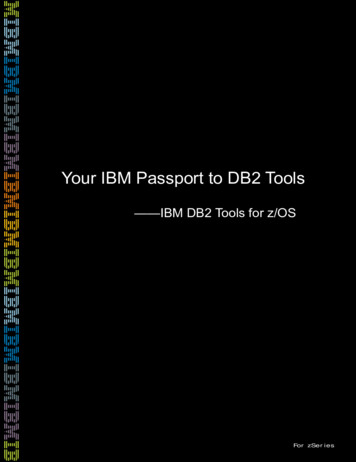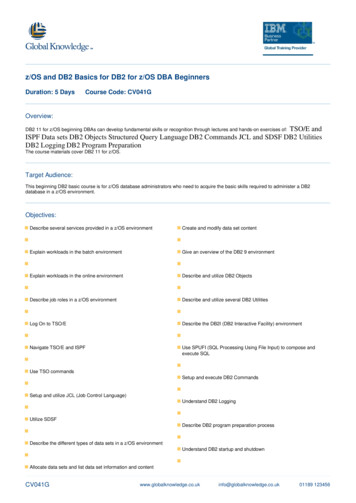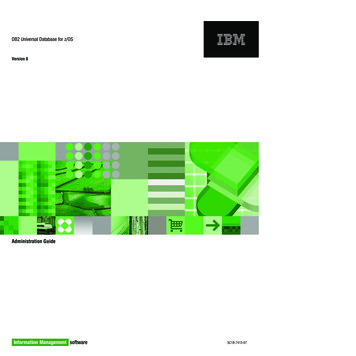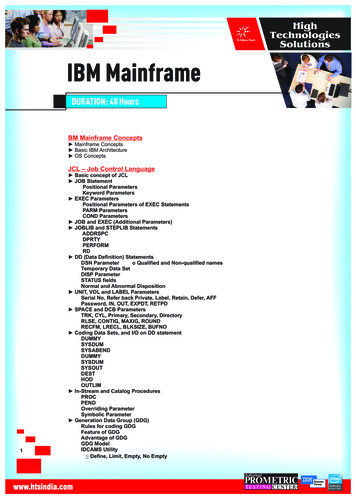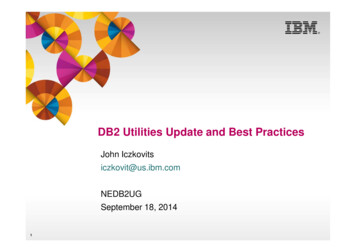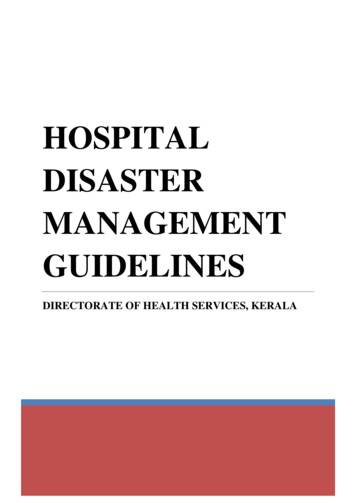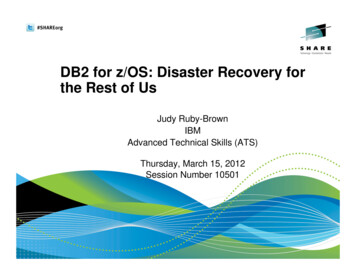
Transcription
DB2 for z/OS: Disaster Recovery forthe Rest of UsJudy Ruby-BrownIBMAdvanced Technical Skills (ATS)Thursday, March 15, 2012Session Number 10501
Notes System Level Backup, consisting of BACKUP SYSTEM and RESTORESYSTEM utilities, was introduced in DB2 V8. Originally created for localrecovery of an entire DB2 subsystem, it has become useful for offsite disasterrecovery scenarios, as its advantages are ease of backup and restoration. . z/OS and DFSMShsm have added functionality through z/OS 1.12. Themeaning of those enhancements for DB2 users are explained in this session inDB2 terms. We take a deeper dive into SLB and discuss some of the nuances. This presentation assumes you are NOT mirroring and you want SLB primarilyfor offsite DR. Setting up the environment takes more time and is usually performed by thestorage administrators. The requirements, how and where to enter the correctvalues are described in the Setup section, to provide DB2 administrators abrief exposure to them.2
Disclaimer Copyright IBM Corporation 2012. All rights reserved.U.S. Government Users Restricted Rights - Use, duplication or disclosure restricted by GSA ADP ScheduleContract with IBM Corp.THE INFORMATION CONTAINED IN THIS PRESENTATION IS PROVIDED FOR INFORMATIONAL PURPOSESONLY. WHILE EFFORTS WERE MADE TO VERIFY THE COMPLETENESS AND ACCURACY OF THEINFORMATION CONTAINED IN THIS PRESENTATION, IT IS PROVIDED “AS IS” WITHOUT WARRANTY OFANY KIND, EXPRESS OR IMPLIED. IN ADDITION, THIS INFORMATION IS BASED ON IBM’S CURRENTPRODUCT PLANS AND STRATEGY, WHICH ARE SUBJECT TO CHANGE BY IBM WITHOUT NOTICE. IBMSHALL NOT BE RESPONSIBLE FOR ANY DAMAGES ARISING OUT OF THE USE OF, OR OTHERWISERELATED TO, THIS PRESENTATION OR ANY OTHER DOCUMENTATION. NOTHING CONTAINED IN THISPRESENTATION IS INTENDED TO, NOR SHALL HAVE THE EFFECT OF, CREATING ANY WARRANTIES ORREPRESENTATIONS FROM IBM (OR ITS SUPPLIERS OR LICENSORS), OR ALTERING THE TERMS ANDCONDITIONS OF ANY AGREEMENT OR LICENSE GOVERNING THE USE OF IBM PRODUCTS AND/ORSOFTWARE.IBM, the IBM logo, ibm.com,FlashCopy, and DB2 are trademarks or registered trademarks of International BusinessMachines Corporation in the United States, other countries, or both. If these and other IBM trademarked terms are markedon their first occurrence in this information with a trademark symbol ( or ), these symbols indicate U.S. registered orcommon law trademarks owned by IBM at the time this information was published. Such trademarks may also be registeredor common law trademarks in other countries. A current list of IBM trademarks is available on the Web at “Copyright andtrademark information” at www.ibm.com/legal/copytrade.shtmlOther company, product, or service names may be trademarks or service marks of others.3
This presentation is Part 1 of a two part presentation. The attendee will benefit by downloading Share presentation: session 10499 DB2 for z/OS System Level Backup Update4
Agenda1. Basic background of System Level Backup (SLB)2. Deeper dive into SLB3. Setup4. Use of SLB for DR recovery (z/OS 1.12)5. SummarySlides titled “Notes” are for your reference and are not shown in the presentation5
Terms used in this presentation 6SLB – System Level Backup (both Backup System/Restore System)FC – FlashCopyFCIC – FlashCopy image copies (DB2 10 only)FRR – Fast Reverse RestoreSEFC – Space Efficient FlashCopyDFSMShsm – (HSM) Hierarchical storage managerDFSMSdss – (DSS) data set servicesFRRECOV – HSM command to restore the Copy PoolsFRBACKUP – HSM command to back up the Copy PoolsCopy Pool Backup Storage Group – CP Backup SG (abbrev)
References DFSMShsm Fast Replication Technical Guide, SG24-7069 IBM System Storage DS8000: Remote Pair FlashCopy (PreserveMirror), REDP-4504 (May, 2009) z/OS V1R12 DFSMS Advanced Copy Services, SC35-0428-18 (z/OS 1.12)DFSMSdss Storage Administration, SC35-0423-14DFSMS Installation Exits, SC26-7396-13DFSMSdfp Storage Administration, SC26-7402-14 DFSMS V1.12 Technical Update, SG24-7895-00 Using the Utilities Suite, redbook, SG24-62897
Introduction to System Level Backup (SLB)DB2 9 8
Background SLB introduced in DB2 V8 for local subsystem-wide recovery for SAP BACKUP SYSTEM utility RESTORE SYSTEM utility Replaced manual steps to obtain a consistent and “instant” backup ofdata, BSDS, active logs, catalog/directory taken while DB2 is active 9-Set Log Suspend operator commandManual submission of FlashCopy or OEM “instant copy” jobsTracking of completion of jobs-Set Log Resume operator command
FlashCopy - What it DoesTimeCopies a Volume.fastCopy data command issuedRelationship starts ( .3 sec)SourceWriteTargetCopy immediately availableReadRead and write to both source andcopy possible while b/g copy runsBackground copyWhen copy is complete,relationship betweensource and target ends10
Notes – many DBAs do not know how FC works Produces ' instant copy' of a volume, as this example shows (can be data set)FlashCopy volumes can only be in a single FlashCopy relationship at any timeSource and Target volumes require real disk space AND must be on the same DASD ssidSource and target volumes must be same track geometrySample JCL for volume level FlashCopy//COPYJOB JOB.//INSTIMG EXEC PGM ADRDSSU//SYSPRINT DD SYSOUT *//SYSUDUMP DD SYSOUT V,OUTLIM 3000//SYSIN DD *COPY FULL INDYNAM (src)) OUTDYNAM (tgt) DUMPCONDITIONING (SMS managed)COPY FULL INDYNAM (src)) O UTDYNAM (tgt) NOCOPYVOLID ( non SMS managed) * 11DFSMSdss checks if source and target are eligible for FlashCopy. If not, DFSMSdss will do a normal copy.Once the FlashCopy "Logical Complete" occurs, the DFSMSdss job completes. It does not wait until thecopy is physically complete (which is performed by the ESS/DS8K hardware)Once the copy is physically complete, the relationship between source and target is ended.NOCOPY reserves space (for copied tracks), but does not start the background copy task. Target is used asa cache for updated tracks only. Secondary Relationship stays till terminated or until all source tracks havebeen copied because they were all updated. For DR tape copies, you would explicitly withdraw it. See z/OS1.12 DFSMS Advanced Copy Services, SC35-0428-18, Ch 26.
BACKUP SYSTEM utility Invokes DHSMShsm services to take fast, (few minutes) minimallydisruptive volume copies of the DB2 data and / or logs No DB2 Quiesce point is required, nothing stops as in SET LOGSUSPEND (thus copy pool volumes are very fuzzy) Two flavors: FULL / DATA ONLY Two sets of SMS Copy Pools (database and log) BACKUP SYSTEM FULL copies both BACKUP SYSTEM DATA ONLY copies database copy pool Make sure active log/BSDS has separate ICF catalog from data12
BACKUP SYSTEMBSDSCOPY1RBA1DBD01 page setCOPY2RBAhCOPY3RBAnRBLPLogscan hCOPY2RBAnCOPY3COPY1DFSMShsm'copy pool backup''copy pool backup'SG1SG2COPY2COPY3LOG1FRBACKUPCOPYPOOL(DSN DSNDB0G DB)token(RBA1)RBLP:RBA1c1c2c3c5c6'DB' copypoolDSN DSNDB0G DB13LogsICFCatalog'Log' copypoolDSN DSNDB0G LGc7c8c9c10c11Backup SystemFULLBackup SystemFULLDB2 DBsRBLP:RBAnRBLP:RBAhc4DB2 DBs'DB' copypoolDSN DSNDB0G DBLOG2LogsBackup SystemDATA ONLYICFCatalog'Log' copypoolDSN DSNDB0G LGDB2 DBs'DB' copypoolDSN DSNDB0G DBDB copypool also contains ICF catalogs for the DBs (not shown above)LogsICFCatalog'Log' copypoolDSN DSNDB0G LG
Notes This picture shows generally three backups at different times: 2 of data andlogs, one of data only. DFSMS stores and tracks them. Various partsnecessary for identification are stored in the BSDS and for restart in theDBD01 header page. Note that the volume copies are fuzzy with respect to the checkpointvalues verbally. Use C2-C3 for example. Due to limitations of the slide, the database copy pool does not show anyICF catalogs while the log copy pool does. Both copy pools contain at leastone ICF catalog. RBLP value is the log scan starting point for log apply phase. Previouscheckpoint value.similar to restart. BSDS RBAnn represents token information including the RBLP denoted byRBA1, 2, n. RBA1 represents the token that is comprised of the concatenation ofSSID Start of STCK RBLP Token is concatenation of SSID - START STCK - RBLP and is ahexadecimal representation of it.14
Restore System Example (locally)6AM2PM4PM6PM8PMTIMELINE of DB2 log Scenario BACKUP SYSTEM is run at 6AM and 6PM daily for SAP system Errors discovered at 8PM Data was correct at 2PM Solution: Restore subsystem to 2PM using SLB from 6AM RESTORE SYSTEM does not restore active logs Locally all logs are available, either as active or archive logs Prepare DB2 for 2PM recovery point15
Prepare DB2 for start up Develop the CRESTART record using time format CRESTART SYSPITRT yyyydddhhmmsst CRESTART SYSPITRT 20111802000000 Assuming day 180 of 2011 (1400 is -6 hours from UTC if CST) Stop xxxxADMT (if it is used)Stop DB2Run Change Log Inventory utility (DSNJU003)Make sure LOGAPSTG 100 in DSNZPARM (V9) Enable fast log apply for faster recovery16
Notes This is SYSPITR to truncate the log. Do not code other values in theCRESTART record If data sharing do for all non-dormant members LOGAPSTG 100 means DB2 uses Fast Log Apply, in this case 500M, sincenothing else is active. In DB2 10 this DSNZPARM has been removed (you getit). V9 100MB log section – 1000 tasks V10 500MB log secion – 1000 tasks Using time is easier, but if you choose, you can determine PITR same old way- via time and translate to RBA or LRSN (if data sharing) For data sharing, do not specify checkpoint frequency in terms of logrecords. A member used primarily for query will not advance the log much.It could set the RBLP used for log apply to a very old value. That becomes the logpoint (use EXACT RBA, no round up). If you are in datasharing, it is a LRSN. If the value is at the end of an archive log, you subtract 1 from the LRSN toavoid spanned log records.17
Recovery of DB2 subsystem Start DB2 DB2 system enters into System Recover Pending state (sets internallyDEFER ALL and MAINT mode) Submit RESTORE SYSTEM utility DB2 invokes DFSMShsm to restore the database copy pool DB2 reads the RBLP and applies all log to 2PM – one pass Automatically – no human hands No “Recover Tablespace Logonly” statements – it is just like restart No complex order - Not single threaded When it completes, System Recover Pending mode is reset Recycle DB2 Following restart, RECOVER or REBUILD PENDING objects18
DB2 Versions Summary DB2 V8 – introduced SLB Copy pools to DASD only Tools like Recovery Expert needed for Tape copies DB2 9 Copy pools to DASD and TAPEIncremental FlashCopy supported for copy pool volumesCan specify SYSPITRT as yyyydddhhmmsst (UTC)Can specify SYSPITR as x’ffffffffffff’ (end of log)Individual table space Recovery from SLB permitted .but restrictions DB2 10 Individual table space recovery from SLB even if table space or partitionmoved via reorg to other volumes Must have enough space on original volumes DFSMShsm option to capture ICF catalog information also required19
Deeper Dive into SLBBackup SystemRestore System20
BACKUP SYSTEM 1. Records the Recover Based Log Point (RBLP) in DBD01 VIP - Starting point for DB2 log apply in the RESTORE utility and iscritical for DR scenarios where additional log is applied2. Invokes DFSMShsm for DASD-DASD copies of “DB” copy pool3. Calls DFSMShsm for DASD-DASD copies of “log” copy pool4. DFSMShsm returns control to DB2 once “logical” copies havecompleted (several minutes) Backups performed in parallel – volumes in pool are fuzzy/unordered5. Issues DSN1614I with Data Complete LRSN – use for laterrecovery6. Resumes quiesced activities Less disruptive than SET LOG SUSPEND 21Allows most updates during backup, but none to ICF CatalogNo delete, define, rename, extend allowed
Notes Since it is a checkpoint value (lowest of all members), make sureCHKFREQ is at least time based for data sharing users 15 DFSMShsm tasks each invoking DFSMSdss with 24 volumes toprocess in parallel achieved (in 2004) 650 3390-3 volumes in THREE minutes (2100 cylinder data) 0.3sec each Customer (non-benchmark) 500 Mod 54s took 5-7 minutes to establish Log MUST be applied as the copy pools can be very fuzzy – each volumeat a different point in time and log records may be written for a volume afterit is copied. Logs are dumped following data for that reason. BSDS DataComplete LRSN is used for “end of the log” Data sharing logs are NOT in sync with each other. Later we see why itmatters. DB2 data can have more than one ICF catalog and they reside in the datacopy pool. Logs must have separate ICF catalog as well as they are backed upsequentially. Prior to V8 customers did not usually separate them.22
Notes DB2 updates the DBD01 header page with the recovery base log point (RBLP)RBA and writes the page to DASD. This field is used by the RESTORE SYSTEMutility to determine the starting point for the log scan for system PIT recovery. DB2 outputs last RBA/LRSN which should be used for later restart – it is safe asit does not depend on whether or not the logs are stripedDSNU1614I - csect-name BACKUP SYSTEM UTILITY FOR object COMPLETEDSUCCESSFULLY, COPY POOL copy-pool-name, TOKEN X'token',DATA COMPLETE LRSN X'rba-or-lrsn', ELAPSED TIME hh:mm:s The message occurs after the backup of the data copy pool. The Data CompleteLRSN is the RBA or LRSN of the last log record written to the active log datasets after the backup of the database copy pool was complete. It is reported inDSNU1614I for the data and logs, as well as recorded in the BSDS. Use it asthe log truncation point for the conditional restart of DB2 for system recovery to apoint in time if the log copy pool is restored. For the database copy pool ('DATA'), message is issued to the Utility job outputand to the system console log. For the log copy pool ( 'LOGS'), it is only issued to the Utility job output.23
Example of FC incremental copy Every version registered to DFSMShsm requires a full set ofDASD for its copy pools – more than 2 is unlikely Assume 2 versions of log and database copy pools to be registered withDFSMShsm DB2 SSID with one data source volume, DB2A, and one log sourcevolume, DB2L DFSMShsm database copy pool backup storage group associatedwith target volumes DB2A1-4 DFSMShsm log copy pool backup storage group associated withtarget volumes DB2L1-424
Day 1 – Begin Incremental Version 1Source – Database Copy PoolTarget – Copy Pool BackupDB2A4Storage Group (SG)DB2A3DB2A2DB2AAll DataDB2A1All Data Day 1 – V1 BACKUP SYSTEM FULL ESTABLISH FCINCREMENTAL Copies data source DB2A to candidate volume in thedatabase CP backup SG, DB2A1, establishes the FCIncremental relationship All tracks on DB2A are copied to DB2A1 Copies logs on DB2L to candidate volume in the log copypool, DB2L1 (not shown)25
Day 2 Day 2 – V2 BACKUP SYSTEM FULL New version created using a different volume in databaseCP backup SG, DB2A2 Copies data source volume DB2A to DB2A2 as full copy FC Incremental exists - only one version in copy pool canhave an incremental relationship Copies log copy volume DB2L in entirety to DB2L226
Day 3Source –Database CopyPoolTarget – Copy PoolBackup SGDB2A4DB2A3DB2A2DB2ADay 2 3DB2A1Day 2 3BACKUP SYSTEM FULL control statemetOnly tracks updated since Day 1 are copied to DB2A127
Day 3 – V3 Day 3 – V3 BACKUP SYSTEM The incremental relationship still exists – while the version may bedeleted, the volumes containing the database CP Backup SG(DB2A1) are not All the tracks of volume DB2A that changed since Day 1 (V1) arecopied to volume DB2A1 and registered as V3 Since 2 versions exist, DFSMShsm rolls off V1, the oldest Dumps log copy volume DB2L in entirety to DB2L1 and registeredas V3 Tape backup of V3 for DR, using BACKUP SYSTEM DUMPONLYDUMPCLASS(DR), contains all tracks of DB2A1 and all the tracks of logcopy pool, DB2L1 Warning: If current version of database copy pool was taken later than logcopy pool, there is a mismatch! (Beware of Backup System DATA ONLY)28
Notes 29The number of versions don’t have to be the same between logs and data.DFSMShsm is unaware of any relationships among copy pools. All it keeps trackof is the number of versions.Incrementals apply only to the database copy pool backup storage groupFor Day 3, DFSMShsm knows that the version that is being replaced is anincremental copy, so it will issue a DFSMSdss command that looks like:COPY IDY(VOLA) ODY(VOLA1) DUMPCOND FR(REQ) PURFCINCREMENTAL If it didn't have the FCINCREMENTAL parameter, a full copy would havebeen made.You can have 1 version registered and still use incrementals
Backup System Options (default FULL)Summary Backup SYSTEM FC Source to Target Copy Pools on DASD – data first, then logs Backup SYSTEM DUMP FC to Copy Pools on DASD – then to tape (after establish for Copy Pools) Backup SYSTEM DUMPONLY Copy the most current version of DASD Copy Pools to Tape Backup SYSTEM DUMPONLY TOKEN(‘xxxx’) Copies the version of DASD Copy Pool Backup SG to tape No effect if only one version of Copy Pool Backup SG30
Restore System notes When copy pool backup storage groups are on DASD (local), DB2 does nothave to wait for the b/g copy to complete – starts log apply when establishphase is complete – faster than volume restores. For DR when CP backup SGs are on tape and are restored to source DASD, b/gcopy must complete first. When DB2 is in System Recover Pending state Only RESTORE SYSTEM utility is allowedSTART DATABASE command is not allowedTERM UTIL command is not allowedDISPLAY UTIL command will display only the status of RESTORE SYSTEM utilitySQL operation is not allowed Claim request on any DB2 objects will be rejected with a -904 SQL code (reason code of00C20269) If you need to run Recover, you must recycle DB2 first.31
Restore System deeper dive6AM2PM4PM6PM8PMOriginal TIMELINE of DB2 log6AM2PM4PM6PM8PMNew TIMELINE of DB2 logABC1. A – Log truncated via SYSPITR2. B – SLB at 6AM chosen and restored. Log ApplySTARTS when Establish Phase completed – no waitfor background copy!!3. C – Log applied to this point
Log apply notes Handles table space CREATEs - will define data sets (DB2-managed) DROPs – will delete data sets (DB2-managed) LOG NO events (Load or Reorg) If LOG NO, the associated object is entered into RECP or RBDP state.Table spaces and indexes with COPY YES attribute marked RECP.Indexes with COPY NO marked RBDP Any objects you "forgot" are placed in LPL when accessed Uses fast log apply (FLA) to recover objects in parallel (6x faster) "Restart logic" applies log to all objects in one pass33
Notes FLA (zparm LOGAPSTG 0 V9) at least 6x faster than without it DB2 9 – 100MB FLA buffer and 1000 tasks DB2 10 – 500MB FLA buffer and 1000 tasks At the end of log apply phase Issues informational message if any object is marked RECP, RBDP or LPL duringthe log apply phase Will occur for new objects created during this phase Releases the PITR lock and PITR state of each member Log apply phase takes periodic checkpoints Writes changed pages to DASD Triggers system checkpoint Updates the DBD01 header page with the new RBLP value RESTORE SYSTEM utility is restartable in the log phase In data sharing, only that member which issued the original RESTORE SYSTEM canissue the restart request34
Restore System w/o log truncation Designed for specialized local recovery where active log exists Think DASD control unit failure with 1000 of objects, BUT active log set intact Restore System probably faster and much easier to do vs. separate Recovers You tell DB2 you want to recover to currency (to end of active log): CRESTART CREATE,SYSPITR FFFFFFFFFFFF No need to run log print utilities – ease of use Can be used for data sharing, BUT logs for each member must represent thesame point Not usually true for Data Sharing Do not use if active logs are striped35
General Restore Systems options summary In all cases you run Change Log Inventory to set the SYSPITR/T andyou make available necessary range of log.1. Restore System DFSMShsm restores DASD database copy pool backup to sourceDB2 volumes (local)2. Restore System FROMDUMP Restores database copy pool on tape to source DB2 volumes (not to DASD CP backup storage group) Note: As long as tape data sets are cataloged and w/i 50 savedBackup Systems, you can go back as far as you have log range Even if one Copy Pool version, you can go back to the -4 tapes3. Restore System LOGONLY You have already restored source DB2 volumes manually. When restarted, DB2 starts at RBLP and processes to “current” This flavor does not require Backup System36
Setup37
Notes: Prerequisites z/OS V1R8 or above for DFSMShsm copy pools on tape (out of service)DASD control units which support ESS Flashcopy APIs – vendor can purchaseDB2 datasets reside on SMS-managed storage groupsWhole subsystem restorationFlashCopy 2 Required for Backup System Incremental Not for Backup System Full, but about 10x slower than FC2 Not for Tape dumpsNFM not requiredSeparate ICF catalogs for Active logs/BSDS from data (can have multiple ICF catalogs)DFSMShsm z/OS V1.11 unallocates ICF catalogs before RESTORE SYSTEM 38DB2 10 for recovery of single object following reorg movement
Copy Pool Storage Group SMS construct, consists of SMS storage groups. Versions attribute allow specification of the number of copy versions to bemaintained on DASD (max is 85).Each version is a complete set of the source DASD, so greater than 2 areunlikely – 1 is okayAdvanced capabilities of FlashCopy are specified on the ISMF Copy Poolbackup storage group definitions.Each DB2 system or data sharing group has two HSM copy poolbackup storage groups with prescribed DB2 naming convention (30bytes in length)1. DATABASE COPYPOOL (DSN location name DB)2. LOG COPYPOOL (DSN location name LG)39
BACKUP SYSTEM setup Copy Pool - finest granularity is SMS Storage Group (SG) Several storage groups for Database Copy Pool Backup SG User data Catalog/directory ICF catalogs containing only definitions for All user data Catalog/directory Storage groups for additional extents if not included in above Do not mix data from another DB2 in the storage groups Do not add other non-DB2 data sets (VSAM, TSO etc) Not required to include work DB (DSNDB07/WRK) Catalog them in a separate ICF catalog40
Notes: Not necessary to include the work database in the copy pool DB2 does nothing with them during either SYSPITR or conditionalrestart, since they are not needed at that time (only the logs are read) During normal restart, DB2 resets the work DB. For DR you can just define them at the recovery site and put them intheir own ICF catalog ie, or include them in the database copy pooland avoid an extra step at the recovery site – your choice. If you do not plan to use the SLB for DR, there is no point to includingthem because they exist locally and the restart following RestoreSystem will reset them.41
BACKUP SYSTEM setup Log Copy pool backup storage group Active logs BSDS ICF catalogs containing only definitions for above Volumes containing only additional extent definition for above Do not mix data from another DB2 (unless data sharing) in the storage groups Do not add other non-DB2 data sets (VSAM, TSO etc) Do not put archive logs in Log copy pool – too many volumes to restore You will need more storage groups when BACKUP SYSTEM is used Place image copies in different ICF catalog and storage group from DatabaseCopy Pool Any inline copies needed for recovery following reorg/load would be lost whenDatabase Copy Pool is restored42
Specification on ISMF Copy Pool Capture Catalog Information – R critical if you want to restore table spacesfrom SLB, but N(one) fine for DR purposes Fast Reverse Restore – can be used only for local recovery ICF catalog names for the copy pool43
Capture Catalog Information1. Used to unallocate ICF catalogs before Restore System ICF catalogs that are part of the copy pool backup storage group also existlocallyThe local version must be unallocated so the backup one can be restoredthrough Restore SystemBefore z/OS 1.11, part of the Restore System process required a manualstep to unallocate all the ICF catalogs that exist on the copy pool backupstorage group.Manual step unnecessary if any option entered other than blank2. Also used to allow recovery of an individual table space/partitionfrom an SLB backup, specifying R/P/N options Described in SLB Update presentation, as it does not apply to offsite DR scenario44
Copy Pool Definition (non-mirrored) Versions – number to keep If 0 means Space Efficient FlashCopy if SEFC volumes available, otherwise it isstandard NOCOPY using tape Options FRRBACKUP and FRRECOV – for users who do not mirror: Blank – same as NO – PPRC Primary volumes cannot be targeted Leave blank if you do not mirror45
Validation of configuration If you change configuration of your source copy pools or copy poolbackup storage groups, validate the backup environment usingHSENDCMD FRBACKUP COPYPOOL(DSN loc DB) PREPAREHSENDCMD FRBACKUP COPYPOOL(DSN loc LG) PREPARE If volume removed from a copy pool backup storage group, and youneed it, RESTORE SYSTEM will fail. If you add volumes to your source for new/changed tables, make surethere are enough volumes in the copy pool backup storage group orBACKUP SYSTEM will fail.46
Summary Setup is not a trivial task – nor fast Tools such as IBM Recovery Expert V2.2 can make sure all data sets areincluded and reduce the labor involved Most work performed by storage team Much movement of data to align correctly in storage groups Once done, much easier to maintain Standards may have to be changed If user has SMS-managed storage but only one storage group; almost the same asno SMS! SLB requires separation of DB2 data from log data – 2 storage groups/SSID or DSGroup minimum Move miscellaneous data sets off the storage groups DB2 staff has to create another ICF catalog for logs, copy them from oldvolumes, and update BSDS. Once setup performed, execution is easy for each utility47
Offsite Disaster Recovery Procedureusing z/OS 1.12 Scenario 1: SLB is restored / restarted Scenario 2: SLB restored – apply morearchive log w/RESTORE SYSTEM48
SLB used for Offsite Disaster Recovery Backup SYSTEM output can be directed to tape – Useful for DR BACKUP SYSTEM FULL DUMP DUMPCLASS(DR) Dumps copy pools to DASD and also to tape BACKUP SYSTEM FULL DUMPONLY DUMPCLASS(DR) Dumps existing copy pools on DASD to tape (BACKUP already performed) Even if incremental versions are used, DUMPCLASS dumps the completeversion (see next slides) Time to dump is that of a FULL Take also the DFSMShsm CDS after the tape dump is complete Transport tapes offsite49
Notes CDS positioning is so it “knows” about the tape dump.otherwise the FRRcommands can’t be used DUMPCLASS specified on DSNZPARM DUMPCLASS name at remote site (DSNTIP6) Assume database copy pool was 1TB. If incremental used it just copiesupdated tracks to the original “1T” copy pools.dumping to tape dumps full 1Tevery time. This is not like incremental image copies. You save time only onbackup system. Also incrementals are not applicable to Restore side, you always restore thefull 1TB. And you can only restore system to the latest incremental, no way togo back to the -1 incremental.50
Use BACKUP SYSTEM FULL If you mix DATA ONLY with FULL, and you later issue DUMPONLY,you might get a mismatch with more current database and less currentlog copy pool. For DR we want the most current versions and wantboth to match: BACKUP SYSTEM FULL (Day 1) BACKUP SYSTEM DATA ONLY (Day 2) (Later) BACKUP SYSTEM DUMPONLY DUMPCLASS(DR) Now there is a mismatch with Day 2 data and Day 1 log – BAD! Usually DB2 will not start51
DR preparation May be better to use DUMPONLY BACKUP SYSTEM stresses source I/O subsystem while FC runs Incremental dumps many fewer tracks reduces stress DUMPONLY is performed after the BACKUP SYSTEM No contention on source volumes Perform at a more convenient time (tape drive availability) Time to dump is same as FULL, even if incremental BACKUP SYSTEM Take CDS so that registration occurs Transport any needed image copies and/or archive logs as before(automated tape libraries) DB2 libraries Libraries must be available or DB2 will not start – z/OS staff takes them to the DR site Do not allow xxxxADMT to start (if used) – set DSNZPARM ADMT ,52
Notes To run FRRECOV or RESTORE SYSTEM, you need the CDS taken after thetape dump completes, space for the production volumes, and both sets ofcopy pools on tape. You do not need any copy pools on DASD, nor do youneed the existing SSID data sets on DASD. DB2 libraries are necessary andare normally taken by z/OS staff. In this scenario both copy pools were produced at the local site usingBACKUP SYSTEM FULL, so the database and logs reflect approximately thesame time For data sharing GRECP recovery is performed automatically during restartand ends with DSNR056I? For each member LPL recovery does not occur automatically during restart. You may see aREASON RESTART during DB2 startup. Following restart, issue start commands for any objects still in LPL.53
Active log issues for striping (simple restart) We are restoring the log copy pool (and restarting DB2) There is a risk that a newer log CI was written and backed up before anolder log CI (for the same active log dataset). DB2 restart cannot handle .especially if a log record spans multiple CIs. For non-data sharing, the FFFFFFFFFFFF cannot be safely be usedfor SYSPITR/T The only safe point is the Data Complete LRSN stored in the BSDS ofthe system on which Backup System was run. If it is an LRSN,
recovery of an entire DB2 subsystem, it has become useful for offsite disaster recovery scenarios, as its advantages are ease of backup and restoration. . z/OS and DFSMShsm have added functionality through z/OS 1.12. The meaning of those enhancements for DB2 users are explained in this session in DB2 terms.
